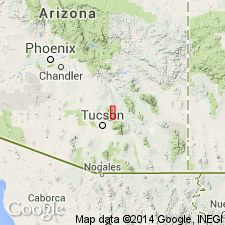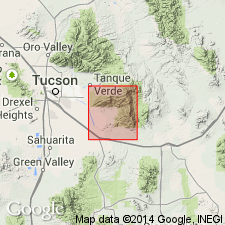
- Usage in publication:
-
- Catalina gneiss
- Modifications:
-
- First used
- Dominant lithology:
-
- Gneiss
- AAPG geologic province:
-
- Southwestern Basin-and-Range region
Summary:
First published use of name; intent to name not stated; no type locality designated; derivation of name not stated. Term used to describe gneissic rocks that make up core of Santa Catalina Mountains and extend southeastward from Mount Lemmon into Tanque Verde and Rincon Mountains. Gneissic rocks are of three general types: banded augen gneiss, augen gneiss, and granitic gneiss-gneissic granite. Banded augen gneiss crops out mainly in southern part of study area, augen gneiss in central part, and granitic gneiss-gneissic granite in northern part. All possible gradations occur between these types. The three types of gneisses have similar mineral compositions of large feldspar crystals in matrix of quartz, feldspar, and biotite. Gneissic rocks in southern part of range were derived from sedimentary and igneous rocks; gneisses in northern part of range were derived from granitic rocks. Author considers rocks in northern part to represent polymetamorphosed granitic rock of igneous origin, formed by metamorphism during older Precambrian and post-Cretaceous time. (Author also uses term "Catalina granite" for a body of post-Cretaceous granite north of Mount Lemmon.)
Source: GNU records (USGS DDS-6; Denver GNULEX).

- Usage in publication:
-
- Catalina gneiss
- Modifications:
-
- Not used
Summary:
Name "Catalina gneiss" replaced by Santa Catalina Group, a name proposed by Blake (1908). Though name Catalina gneiss has been widely used in Tucson, AZ area since DuBois (1959, Ariz. Geol. Soc. Guidebook II, p.114) and McColly (1961, Ariz. Geol. Soc. Digest, v.4, p.87-92), formal adoption of name "Catalina" may lead to confusion with a similarly named Precambrian unit in CA. Study area is in Rincon Valley area, Pima Co, AZ (Southwestern Basin-and-Range region).
Source: GNU records (USGS DDS-6; Denver GNULEX).
For more information, please contact Nancy Stamm, Geologic Names Committee Secretary.
Asterisk (*) indicates published by U.S. Geological Survey authors.
"No current usage" (†) implies that a name has been abandoned or has fallen into disuse. Former usage and, if known, replacement name given in parentheses ( ).
Slash (/) indicates name conflicts with nomenclatural guidelines (CSN, 1933; ACSN, 1961, 1970; NACSN, 1983, 2005, 2021). May be explained within brackets ([ ]).

